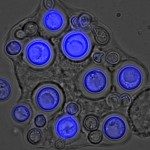Link to Pubmed [PMID] – 22800082
Med. Mycol. 2013 Feb;51(2):155-63
Antifungal prophylaxis with liposomal amphotericin B in high-risk liver transplant recipients is recommended, but experience with amphotericin B lipid complex (ABLC, Abelcet(®)) in this setting is limited. Data from 615 liver transplants performed during 1999-2005 were analyzed retrospectively. High-risk patients (n = 146) received a mean cumulative ABLC dose of 955 ± 609 mg (mean duration of 23.3 ± 11.9 days). Low-risk patients (n = 469) received no prophylaxis. During a mean follow-up of 43.8 ± 29.2 months, fungal infections occurred in 32.2% of ABLC patients versus 43.5% of non-prophylaxis patients (P = 0.015). The overall rate of invasive fungal infection was 12.3% in the ABLC group versus 15.6% in the non-prophylaxis patients (P = 0.34). Any Candida infection (ABLC 29.5%, non-prophylaxis 41.2%, P = 0.011), probable or proven invasive Candida infection requiring systemic antifungal treatment (ABLC 18.5%, non-prophylaxis 32.4%, P = 0.001) and invasive abdominal candidiasis during the first 3 months (ABLC 4.1%, non-prophylaxis 9.2%, P = 0.049) were significantly less frequent in the ABLC group. There was no significant difference between groups in the incidence of Aspergillus infections. The ABLC group showed no evidence of nephrotoxicity. In conclusion, the marked and significant differences in infection rates and requirement for systemic treatment in this large population suggest that targeted use of low-dose ABLC therapy to high-risk patients is a valid prophylactic strategy following liver transplantation.

